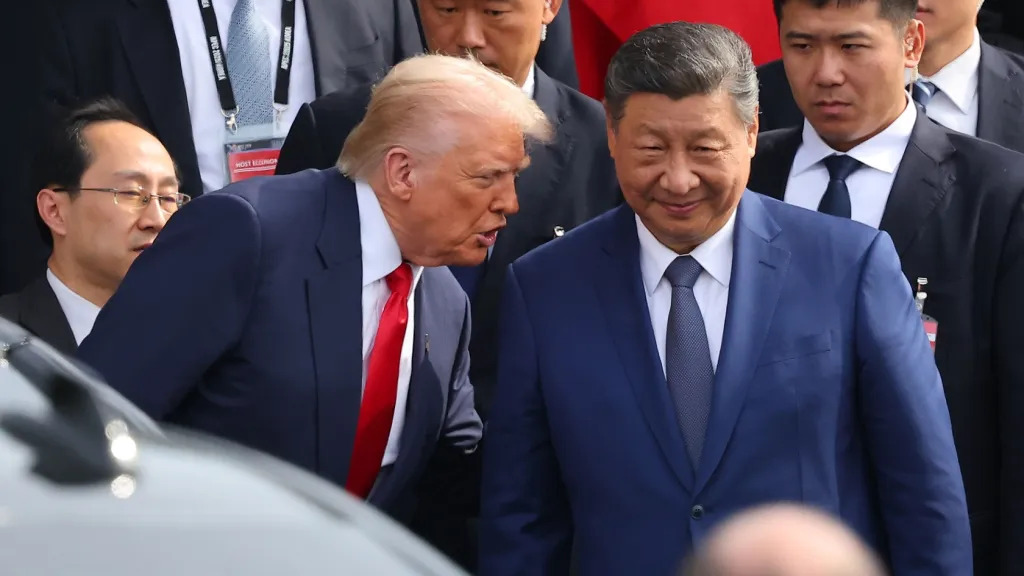The first in-person meeting between Presidents Trump and Xi in six years focused almost exclusively on trade and technology, resulting in a temporary rollback of tariffs and export restrictions but producing no new agreements or progress on broader security or geopolitical issues. The meeting largely served to stabilize U.S.-China relations and decrease tensions, with both leaders agreeing to reciprocal visits in 2026 for further discussions, effectively “kicking the can down the road” on deeper bilateral challenges.

U.S. President Donald Trump and Chinese President Xi Jinping meet in Busan, South Korea, October 30 2025. (Photo: Yonhap News/Sipa USA)
Sometimes in diplomacy doing a little is doing a lot and no news is good news. The high-profile meeting this week in South Korea between Presidents Donald Trump and Xi Jinping was their first in-person meeting since 2019 and it came after years of continually rising tensions between the two countries. The meeting’s major accomplishment may be that it occurred at all and did so without apparent rancor. Clearly, both sides aimed to project bonhomie between the two presidents, while dialing down the heat and trade tensions of recent months. President Trump pronounced the meeting “a great success!”
This is important, as the fraught U.S.-China relationship could certainly do with a little stability after a decade of steadily increasing comprehensive competition and the rollercoaster of the past nine months’ tit-for-tat trade actions between the two sides.
However, little of substance concerning the overall relationship was accomplished—or even discussed—at the meeting. The relatively brief one-hour, forty-minute meeting was totally about the bilateral commercial relationship, with apparently no other international or regional security issues discussed (although President Xi apparently congratulated President Trump for the role he played in achieving the Israel-Hamas accords and Gaza ceasefire). Surprisingly, even the touchy Taiwan issue did not come up (even in a perfunctory way in which each side normally delivers well-rehearsed positions), and it does not seem that Trump pressed Xi on China’s support for Russia’s war against Ukraine (and possibly playing a more constructive role in bringing about a ceasefire there). Nor was the South China Sea or other Asian security issues such as North Korea on the agenda.
The focus of the talks was entirely about trade and technology. Even in this domain there weren’t any new initiatives and agreements announced—as both sides essentially returned to the status quo of previous months. The forward progress had to do with returns to past positions. Both sides took their most punitive threats off the table: China agreed to suspend implementation of its global export control regime on products containing rare earth minerals mined and processed in China; in return, the United States said it would also pause export restrictions for one year on subsidiaries of Chinese companies already on Washington’s “Entity List.” For his part, Trump also took off the table his threatened 100% tariffs (which were due to come in force on November 1st) and he reduced tariffs related to fentanyl chemical precursors from 20% to 10%–thus lowering the overall U.S. tariff rate on China to 47%.
For his part, President Xi did not win any relaxation of U.S. high-technology export controls (perhaps China’s main aim). Trump also postponed a Section 301 investigation into Chinese shipbuilding. A status of a second 301 investigation the Trump administration recently launched concerning China’s failure to fully implement the bilateral 2018 by not fulfilling its pledges to buy large amounts of U.S. agricultural products remains unclear, but presumably has been assuaged by President Xi’s promise to lift its freeze on imports of American soybeans by immediately purchasing 12 million tons with an additional 25 million tons each year for the next three years. The two sides will also pause reciprocal port fees for ships (which is a big win for China). Oddly, bilateral cross-investment was not even listed among the items each side gave in their subsequent readouts.
Thus, both sides stepped back from the brink, perhaps signaling a mutual recognition that a U.S.-China trade war cannot be won given the deep interdependencies of the two economies. It remains to be seen, however, whether they think a tech war cannot be won—as both sides continue to weaponize their export controls, intensify their respective investments and R&D in artificial intelligence, and China pursues an autonomy in the production of a wide range of high-tech products.
The outcome of the Xi-Trump meeting is thus, on balance, very positive. It has served to stabilize the relationship and set a new tone of mutual respect and professional interactions. At least the two sides do not seem—for now—in a race to the bottom. How long will this temporary truce last? There remain details of the Korea agreements to be fleshed out and implemented, which officials from both sides are to do in the coming weeks.
Most of all, there remains a long litany of other issues—mainly related to regional and global security—that need to be addressed. For Beijing, U.S. support for Taiwan remains primary. For Washington, the impact of China’s military buildup on regional security in the Indo-Pacific remains primary, with China’s assistance to Russia’s war against Ukraine also high on the agenda. These troublesome issues will continue to percolate over time.
The final outcome of the Trump-Xi tête-à-tête is that the two leaders agreed to reciprocal visits to each other’s country in 2026. Trump revealed on the way back to Washington that he has been invited and plans to visit Beijing in April. That will provide the opportunity for more wide-ranging discussions and possibly a “reset” of the broader U.S.-China relationship. For the time being, though, both sides have bought time and lowered the temperature, and that is a good thing.
